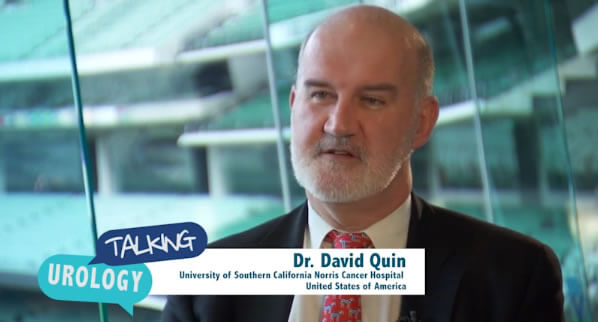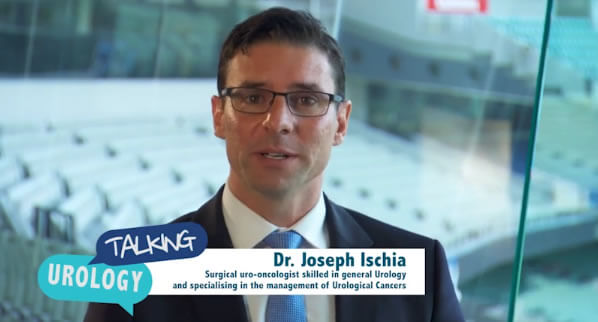ANZUP 2017 – Dr Alex Kutikov
Dr Alex Kutikov discusses his new metric for determining the utility of MRI-US fusion prostate biopsy.
Talking Urology podcast transcript
ANZUP 2017 Interviews - Henry Woo and Alex Kutikov
Henry Woo: I’m Henry Woo, I’m a urologist from Sydney and I’ve got with me Professor Alex Kutikov who’s a professor of neurology at the Fox Chase Cancer Center. We’re very interested Alex in your presentation about the role of fusion MRI prostate biopsy. In particular you’re using a new metric to gauge what we’re trying to gauge, I guess, the benefit of this approach for our patients undergoing prostate biopsy Would you like to comment on that?
Alex: That’s right Henry. Well, thank you so much for having me. What a privilege. Melbourne, I learned today, is the most livable city in and I couldn’t agree more. What a beautiful place. What we’re trying to do is we’re trying to understand better what the deliverable of MRI technology is and the way that the literature is reported sometimes can be confusing. The sensitivity, specificity, those classic test characteristics can be a little bit deceiving in terms of what we’re actually delivering for our patients.
For instance, when a patient comes to me with an elevated PSA and I talk to him about receiving an MRI, that’s a big ask. He has to go and get an MRI sometimes with an endorectal coil then he has to come back to me to discuss the MRI results and then he has to go for a biopsy. And so, sometimes patients asked me, what are what are the benefits? What are we going to find if I go through that process that we weren’t going to find if I didn’t go through the process? The other question that you get in clinics a lot is, “Doc, if you’re doing the targeted biopsy, if you’re doing the fusion biopsy if the lesion that you see on the MRI, why are you still doing the 12-core template?” And so, what we tried to do in this study that’s now in peer review is we try to sort of pare down the data and create two metrics. One is called the actionable intelligence matrix, the AIM, and what that communicates to us is how much high rate disease that we find on the targeted biopsy that we didn’t find on the concomitant 12-core biopsy. And then the other metric is, the reduction metric, in what percentage of patients could we drop the template biopsy and still find the disease that we want to find? And that’s very important because in reality, this deliverable of targeted technology that we hear about where we’re going to find less low-risk disease and thus sort of mitigate the overdiagnosis issue only works if we drop the 12-core template. How many in what percentage of our patients can we actually drop the 12-core template? That really depends on how good our MRI is and what the institution is. We have these two metrics that where we’re hopeful we’ll get take traction and give some clarity to this literature.
Henry: I’m going to pull you up on your, I guess, on your thoughts about abandoning the 12‑core biopsy in that fairly consistently a lot across many studies, it’s been demonstrated that MRI can miss as many as 20 to 25% percent of clinically significant lesions.
Alex: Absolutely, that’s right. But if you actually look at the data and you use this reduction metric that we’re proposing, it actually communicates a little bit better what percentage of time you find the important lesion on your targeted biopsy. Now, you have to sort of remember that we’re taking the group that actually has lesions, right? So, we’re already sort of filtering out those individuals that didn’t have a lesion on MRI for whom we did or did not do a biopsy. We’re only looking at folks in whom we had the lesion, right? So, that’s already the 85 to 90% of high-risk disease at MRI diagnosis. Now, in those in those patients, how many times did the 12-core biopsy hit the lesion while the targeted biopsy didn’t, right? That’s what this communicates. A little bit of a different sort of nuance here because yes, absolutely MRI itself misses a certain percentage of lesions. But then, what we’re talking about here is if you do have a lesion, what percentage of time can you drop the 12-core biopsy if you have that lesion, and again, an important decision point in clinical practice.
Henry: I’d like to take you back to the, let’s say for example, the AIM metric. What do you consider to be the threshold? This is the first time we’ve ever seen this metric presented. What do you think is the threshold where it has some clinically relevant meaning to us? Now, in your study, I think it was around the 25%.
Alex: That’s exactly right.
Henry: Is it 10%, 40%?
Alex: Measure is the only way to know, right? I think Tesla said that. But right now, most series are 25 to 30%, so basically in 25 to 30% of patients, it was worthwhile for them to go through the MRI fusion biopsy process. Whereas in over 70% of patients, if you did the 12-core template on top of the targeted biopsy, you had no additional information that you gain from the targeted biopsy, so that’s important for us to know. Yes, I think 25% for most men is enough, but I think again, it’s a clinical decision. I mean, if you have an elderly patient with an elevated PSA that is very nervous and you just want to kind of take aggressive disease off the table, in my opinion, it’s a clinical decision whether to put them through the MRI fusion biopsy or just to do a 12-core template and move on.
Henry: This is all very interesting and certainly the first time that many of us in this audience have actually heard about these new metrics but I’m very sure that we’re going to see a lot more about this and congratulations on your work and we’ll look forward to seeing the publication in due course. Thank you very much again.
Alex: Thank you Henry. Thank you very much.












